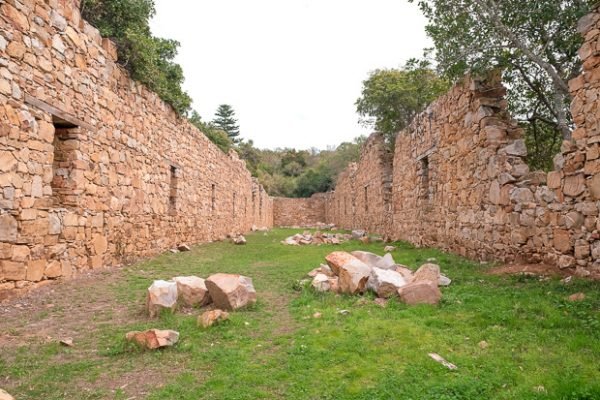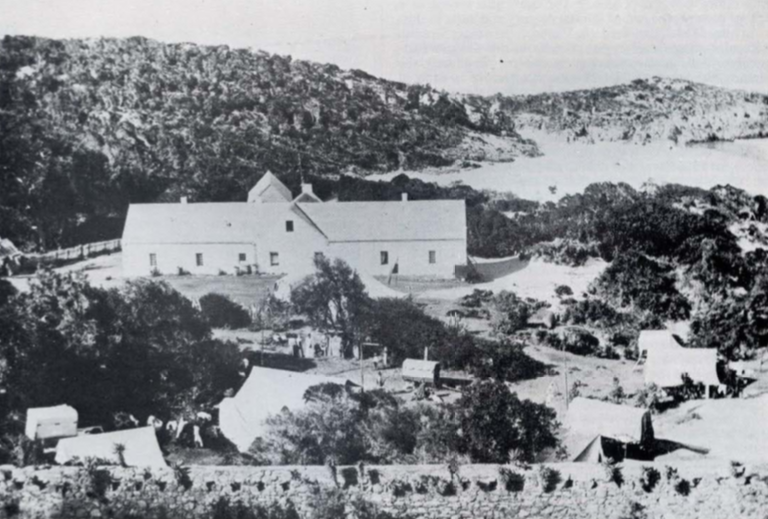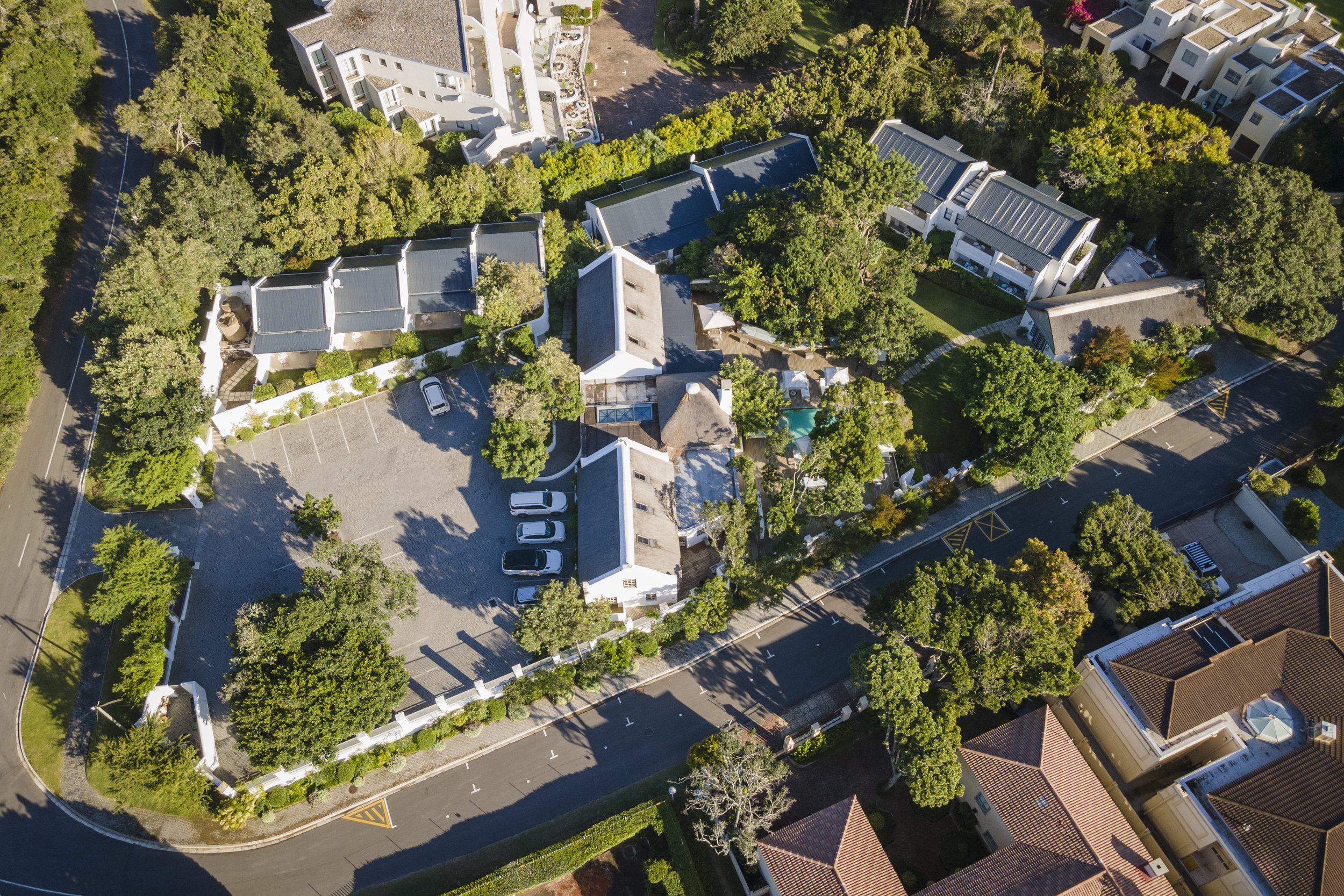The history of The Old Rectory dates back to 1777, when it was first built to house troops supervising the storage and shipment of timber by the Dutch East India Company (VOC). It is the oldest surviving building in Plettenberg Bay and certainly one of the most significant, due to its rich past that is intertwined with the history of the Garden Route. It also has value as a National Monument, forming an important piece of the area’s cultural heritage.
The original building – then a barracks for VOC troops supervising timber shipments out of Plettenberg Bay – sometime during the 1800s (Credit: The Van Plettenberg Historical Society)
While it has recently been restored and expanded in its modern reinvention as The Old Rectory Hotel & Spa, in the heart of a bustling holiday town, its surroundings in the late 18th century would have been very different. At the time, Plettenberg Bay – or as it was known until 1778, Bahia Formosa; ‘Beautiful Bay’ in Portuguese – sat amongst farmland and thick indigenous forest on the outskirts of a British colony. Indeed, even as late as the early 1920’s, the town comprised of only two shops, The Old Rectory, three houses, six shacks and a boarding house.
The main reception area of the current-day hotel showing two sections of original stone (built by the Dutch) and mud brick (built later by the British) walls
The fully-restored original stone wall in the dining room with its beautiful pointing
Clues to the early history of the property lie in its architectural details and archives. Notations on a plan of Plettenberg Bay drawn by J.C. Frederici in the late 1700s describe the house and timber store as the ‘pakhuis en militaaren logies’, alluding to its origins as a barracks. This is a reminder that life along this stretch of idyllic coastline was once fraught with danger for those living there; its seaward-facing position undoubtedly chosen in a defensive measure against some hostile force during what was an unstable time politically.
When John Barrow, the private secretary to the Earl Macartney, was sent to report on the ‘lesser-known’ areas of the British colony in 1797 – Plettenberg Bay among them – his findings included the ships ‘landing place’ (Beacon Island beach) and a glowing impression of The Old Rectory and its command of the foreshore.
The whaling station at Plettenberg Bay in the late 19th Century (Credit: Plett Tourism)
‘A new and handsome dwelling house, a magazine for the reception of timber, two hundred feet in length, and a strong commodious building for the reception of troops.’
Although that ‘handsome dwelling house’ no longer exists, the ‘strong commodious building’ is today the main reception area and restaurant of the hotel.
As one of its first inhabitants, the building had housed a man by the name of Johann Friedrich Meeding. His appointment as Commandant of the Swart River woodcutter’s post came by way of Baron Joachim van Plettenberg, who had arrived in Plettenberg Bay in 1778 and proclaimed the town his namesake.
Woodcutters work a pit saw in the Knysna Forest, late 1800s (Credit: Municipality of Knysna)
Van Plettenberg’s concern over the potential destruction of the natural forests and overuse of timber by the Dutch settlers prompted him to propose some preventative measures to the Lords XVII of the VOC. Meeding was consequently stationed in the house as Postholder to manage resources on behalf of the VOC. He subsequently built his own residence and moved out, at which time the building is believed to have stood vacant.
It was then reoccupied early in the 19th century, most notably by professional whaler, Captain John Sinclair, and his wife Julia Maria, who lived there together until his death 1859.
The current state of The Old Timber Shed which sits adjacent to The Old Rectory and, although currently derelict, is also a National Monument (Credit: Misha Levin)
After Sinclair’s death, the Government bought ‘The Barracks’ for £1,000 but sold it again ten years later for £200 to Bishop Robert Gray, on behalf of the Anglican Church. The sale included 18 acres of land along the foreshore, effectively granting landing rights to the Church.
“The property will even yet, I trust, become valuable to the Church”, wrote Bishop Gray. “At all events it offers an excellent residence for our Missionary.”
The Old Rectory circa 1900, after the thatched roof was replaced with a corrugated iron one and the central courtyard enclosed in 1887 (Credit: The Heritage Association of South Africa)
The building then became known as The Rectory and housed men of the cloth, their families and missionaries for the next 70 years, until 1939 when a new rectory was built. Only one major alteration is recorded for the building during that time, when the rotting thatched roof was replaced with a corrugated iron one in 1887. At the same time, a courtyard separating two sections of the building was also enclosed, forming the long, continuous floorplan we see today.
The Church sold the property in 1940, where it remained in the Crawford family for 40 years before ultimately coming into the hands of the Leghs who were responsible for its transformation into a luxurious beach escape.
The spa building at The Old Rectory; once a small chapel and school house (Credit: @cabin_fever_cpt)
Of note is also the wooden barn on the northern side of the house, in which Bishop Gray was known to have held services. This practice persisted until 1875, when the first iteration of the neighbouring St Peter’s Church was built. The barn also served as a school towards the end of the 1800s and beginning of the 1900s and is now The Old Rectory Hotel’s tranquil in-house spa.
Visitors to the house over the centuries have also provided an interesting record of its history. Among these was the renowned South African novelist Pauline Smith, who stayed in The Rectory (as it was then) in October 1913 as a guest of Reverend W. Gratton Sharples. She described the red iron roof, thick walls and small-paned casement windows (uncommon in the area) as well as the austerity of the interior – wooden buttons fastened the windows and ‘none of the rooms were papered, but rather whitewashed’.
An aerial view of the hotel as it stands today, with the spa building at right, the original rectory building in the centre and centuries-old milkwood trees surrounding the pool.
Such testimonies and photographs were key to understanding the history of the building, and strongly informed the work of the architects tasked with the recent restoration. They had to decide which period of its existence to ‘hone in on’, ultimately choosing as a reference point the earliest photo they could find, which showed a Cape Dutch silhouette.
The building’s architectural heritage is paired with striking South African art expertly curated by Michele Bestbier. These colourful works perfectly complement Align Design’s bright, contemporary interiors; a modern look and feel that serves to elevate the beauty of features such as the original yellowwood floors, oak beams and stone walls.
Our luxury suites are inspired by the colours of the Garden Route landscape and complemented by unique pieces of handpicked South African art.
Amazingly, aside from the relatively minor update in 1887, very few structural alterations have been made to this landmark, making it a rare piece of architectural and cultural history that remains virtually intact from the days of its construction roughly 250 years ago.
Now a bright, eclectic boutique hotel with its own restaurant and spa, The Old Rectory has been reborn to continue its legacy of welcoming travellers and families to the lush coastline of the Garden Route. Filled with character, the hotel offers laidback luxury and a restful haven from the vibrant energy of one of South Africa’s most beloved seaside towns.
With thanks to Patricia Storrar and her 1981 article in “Restorica”; the journal of the Simon van der Stel Foundation (today the Heritage Association of South Africa).























